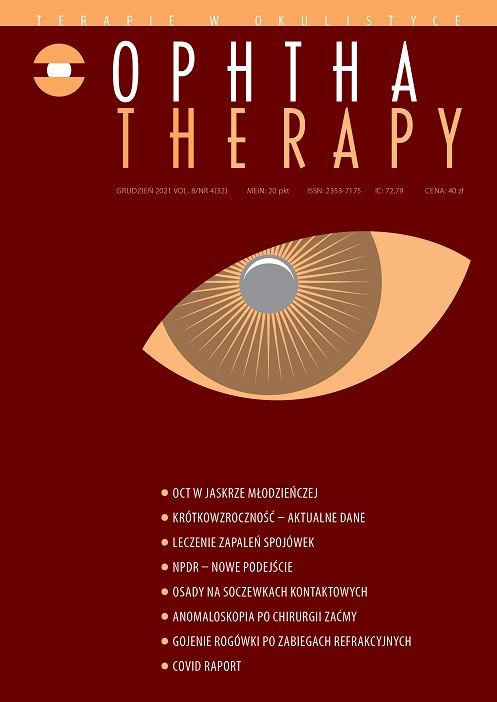Antibiotic therapy of bacterial conjunctivitis – a practical approach Review article
Main Article Content
Abstract
The most common cause of ophthalmological consultations in an ophthalmological clinics are conjunctivitis, often caused by bacteria. The main form of its treatment is topical antibiotic therapy. The paper presents the current possibilities of treatment of conjunctivitis, with particular emphasis on the problem of development of the antibiotic resistance and the practical principles of antibiotic therapy. In the light of current knowledge, the best results in the treatment of bacterial conjunctivitis are achieved by the use of IV- and then III-generation of fluoroquinolones. These drugs have the best spectrum of action, and additionally, they have a very good penetration into the conjunctiva and are at the lowest risk of developing antibiotic resistance.
Downloads
Article Details

This work is licensed under a Creative Commons Attribution-NonCommercial-NoDerivatives 4.0 International License.
Copyright: © Medical Education sp. z o.o. License allowing third parties to copy and redistribute the material in any medium or format and to remix, transform, and build upon the material, provided the original work is properly cited and states its license.
Address reprint requests to: Medical Education, Marcin Kuźma (marcin.kuzma@mededu.pl)
References
2. Petricek I, Prost M, Popova A. The differential diagnosis of red eye: A survey of medical practitioners from Eastern Europe and the Middle East. Ophthalmologica. 2006; 220: 229-37.
3. Filipek B, Prost M. Leki stosowane w leczeniu chorób infekcyjnych oczu. In: Prost M, Jachowicz R, Nowak JZ (ed). Kliniczna farmakologia okulistyczna, 2nd ed. Elsevier, Wrocław 2016.
4. Oksuz L, Ozbilen KT. A Three-Year Analysis of Ocular Infections in a Tertiary Care University Hospital in Turkey. Clin Lab. 2021; 67: 9-10.
5. Prost M. Podstawy antybiotykoterapii schorzeń powierzchni oka. OphthaTherapy. Terapie w Okulistyce. 2014, 1: 26-32.
6. Hauser AR. Antibiotic basics for clinicians: The ABCs of choosing the right antibacterial agent. Lippincott Williams & Wilkins, Philadelphia 2012.
7. Blondeau JM. Fluoroquinolones: Mechanism of action, classification, and development of resistance. Surv Ophthalmol. 2004; 49(suppl 2): S73-S8.
8. Wagner RS, Abelson MB, Shapiro A et al. Evaluation of moxifloxacin, ciprofloxacin, gatifloxacin, ofloxacin, and levofloxacin concentration in human conjunctival tissue. Arch Ophthalmol. 2005; 123: 182-3.
9. Stewart WC, Crean CS, Zink RC et al. Pharmacokinetics of azithromycin and moxifloxacin in human conjunctiva and aqueous humour during and after the approved dosing regimens. Am J Ophthalmol. 2010; 150: 744-51.
10. Katz HR, Masket S, Lane SS et al. Absorption of topical moxifloxacin ophthalmic solution into human aqueous humour. Cornea. 2005; 24: 955-8.
11. Kim DH, Stark WJ, O’Brien TP et al. Aqueous penetration and biological activity of moxifloxacin 0,5% ophthalmic solution and gatifloxacin solution in cataract surgery patients. Ophthalmology. 2005; 112: 1992-6.
12. Lai WW, Chu KO, Chan KP et al. Differential aqueous and vitreous concentrations of moxifloxacin and ofloxacin after topical administration one hour before vitrectomy. Am J Ophthalmol. 2007; 144: 315-8.
13. Ong-Tone L. Aqueous humor penetration of gatofloxacin and moxafloxacin eyedrops given be different methods before cataract surgery. J Cataract Refract Surg. 2007; 33: 59-62.
14. McCulley JP, Caudle D, Aronowicz JD et al. Fourth-generation fluoroquinolone penetration into the aqueous humor in humans. Ophthalmology. 2006; 113: 955-9.
15. Yagci R, Oflu Y, Dincel A et al. Penetration of second-, third-, and fourth-generation of topical fluoroquinolone into aqueous and vitreous humour in a rabbit endophthalmitis model. Eye. 2007; 21: 990-4.
16. Yamada M, Mochizuki H, Yamada K et al. Aqueous humor levels of topically applied levofloxacin, norfloxacin and lomefloxacin in the same human eyes. J Cataract Refract Surg. 2003; 29: 1771-5.
17. Hwang DG. Fluoroquinolone resistance in ophthalmology and the potential role for newer ophthalmic fluoroquinolones. Surv Ophthalmol. 2004; 49(suppl 2): S79-S83.
18. Prost M, Semczuk K. Antybiotykooporność szczepów bakteryjnych worka spojówkowego u dzieci. Klin Oczna. 2005; 107: 418-20.
19. Alabaiad CR, Miller D, Schiffman JC et al. Antimicrobial resistance profiles of ocular and nasal flora in patients undergoing intravitreal injections. Am J Ophthalmol. 2011; 152: 999-1004.
20. Fintelmann RE, Hoskins EN, Lietman TM et al. Topical fluoroquinolone use as a risk factor for in vitro fluoroquinolone resistance in ocular cultures. Arch Ophthalmol. 2011; 129: 399-402.
21. Kim SJ, Toma HS. Ophthalmic antibiotics and antimicrobial resistance: A randomized, controlled study of patients undergoing intravitreal injections. Ophthalmol. 2011; 118: 1358-63.
22. Deschênes J, Blondeau J. Besifloxacin in the management of bacterial infections of the ocular surface. Can J Ophthalmol. 2015; 50: 184-91.
23. Keen M, Thompson M. Treatment of Acute Conjunctivitis in the United States and Evidence of Antibiotic Overuse: Isolated Issue or a Systematic Problem? Ophthalmology. 2017; 124: 1096-8.
24. Dortonne I, Colmenares, P, Lyford T et al. Evaluation of infectious conjunctivitis by clinical evaluation and novel diagnostics. JUCM. 2019; 10: 11-5.
25. Gominet M, Seghezzi N, Mazodier P. Acyl depsipeptide (ADEP) resistance in Streptomyces. Microbiology. 2011; 157: 2226-34.

